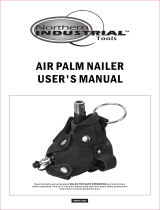INTRODUCTION
The Bostitch N88 is a precision-built tool, designed for high speed, high volume
nailing. These tools will deliver efficient, dependable service when used correctly and with
care. As with any fine power tool, for best performance the manufacturer’s instructions must
be followed. Please study this manual before operating the tool and understand the safety
warnings and cautions. The instructions on installation, operation and maintenance should be
read carefully, and the manual kept for reference. NOTE: Additional safety measures may be
required because of your particular application of the tool. Contact your Bostitch representative
or distributor with any questions concerning the tool and its use.
Bostitch, Inc., East Greenwich, Rhode Island 02818.
INDEX
Safety Instructions . . . . . . . . . . . . . . . . . . . . . . . . . . . . . . . . . . . . . . . . . . . 3
Tool Specifications . . . . . . . . . . . . . . . . . . . . . . . . . . . . . . . . . . . . . . . . . . . 4
Air Supply: Fittings, Hoses, Filters, Air Consumption, Regulators,
Operating Pressure, Setting Correct Pressure . . . . . . . . . . . . . . . . . . . . . . . 5
Lubrication . . . . . . . . . . . . . . . . . . . . . . . . . . . . . . . . . . . . . . . . . . . . . . . . . 5
Loading the Tool, Fastener Depth Control Adjustment . . . . . . . . . . . . . . . . 6
Removing Nails, Directional Exhaust . . . . . . . . . . . . . . . . . . . . . . . . . . . . . . 7
Tool Operation . . . . . . . . . . . . . . . . . . . . . . . . . . . . . . . . . . . . . . . . . . . 8 & 9
Maintaining the Pneumatic Tool . . . . . . . . . . . . . . . . . . . . . . . . . . . . . . . . . 10
Trouble Shooting . . . . . . . . . . . . . . . . . . . . . . . . . . . . . . . . . . . . . . . . . . . 11
Driver Maintenance . . . . . . . . . . . . . . . . . . . . . . . . . . . . . . . . . . . . . . . . . . 12
NOTE:
Bostitch tools have been engineered to provide excellent customer satisfaction and are
designed to achieve maximum performance when used with precision Bostitch fasteners
engineered to the same exacting standards.
Bostitch cannot assume responsibility for product performance if our tools are used
with fasteners or accessories not meeting the specific requirements established for
genuine Bostitch nails, staples and accessories.
LIMITED WARRANTY
Bostitch, Inc., warrants to the original retail purchaser that this product is free from
defects in material and workmanship, and agrees to repair or replace, at Bostitch's option,
any defective product within 1 year from the date of purchase.This warranty is not
transferable. It only covers damage resulting from defects in material or workmanship, and it
does not cover conditions or malfunctions resulting from normal wear, neglect, abuse, accident or
repairs attempted or made by other than our regional repair center or authorized warranty
service center. Driver blades, bumpers and o-rings are considered normally wearing parts.
THIS WARRANTY IS IN LIEU OF ALL OTHER EXPRESS WARRANTIES. ANY WARRANTY
OF MERCHANTABILITY OR FITNESS FOR A PARTICULAR PURPOSE IS LIMITED TO THE
DURATION OF THIS WARRANTY. BOSTITCH SHALL NOT BE LIABLE FOR ANY
INCIDENTAL OR CONSEQUENTIAL DAMAGES.
This warranty is limited to sales in the United States and Canada. Some states do not allow
limitations on how long an implied warranty lasts, or the exclusion or limitation of incidental or
consequential damages, so the above limitations or exclusions may not apply to you. This
warranty gives you specific legal rights, and you may also have other rights which vary from
state to state.
To obtain warranty service, return the product at your expense together with proof of
purchase to a Bostitch Regional or authorized warranty repair center. You may call us at
1-800-556-6696 for the location of authorized warranty service centers in your area.
-2-












